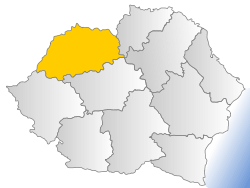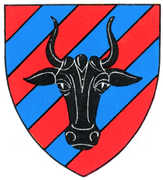Ținutul Crișuri
| Ținutul Crișuri Ținutul Someș | ||
|---|---|---|
| Land (Ținut) | ||
| ||
 | ||
| Country |
| |
| Former counties included | Bihor County, Cluj County, Maramureș County, Sălaj County, Satu Mare County, Someș County, Năsăud County | |
| Historic region | Transylvania (Maramureș, Crișana) | |
| Capital city (Reședință de ținut) | Cluj | |
| Established | The administrative reform of 1938 | |
| Cesed to exist | Territorial loss and new administrative law (30 August 1940) | |
| Government | ||
| • Type | Rezident Regal | |
| Area | ||
| • Total | 33,385 km2 (12,890 sq mi) | |
| Population (1938 (?)) | ||
| • Total | 2.143.453 | |
| Time zone | UTC+2 (EET) | |
| • Summer (DST) | UTC+3 (EEST) | |
Ținutul Crișuri (or Ținutul Someș) was one of the ten ținuturi ("lands") of Romania, founded in 1938 after King Carol II initiated an institutional reform by modifying the 1923 Constitution and the law of territorial administration. It comprised part of Transylvania, and included the entire regions of Crișana and Maramureș. It was named after the rivers Crișul Alb, Crișul Negru, and Crișul Repede; its capital was the city of Cluj. Ținutul Crișuri ceased to exist following the territorial losses of Romania to the Axis powers in 1940.
Coat of arms
The Coat of Arms is composed of 7 sinister bends, 4 of gules and 3 of azure, representing the former seven counties (județe) of the Greater Romania (71 in total in 1938) it included. Over the mirror bends there is a sable aurochs head (in reference to Voivode Dragoș of Maramureș, and to the symbol of Moldavia - see Flag and coat of arms of Moldavia).
Former counties incorporated
After the 1938 Administrative and Constitutional Reform, the older 71 counties lost their authority.
In 1939 Turda County was ceded to Ținutul Mureș in exchange for Năsăud County.
